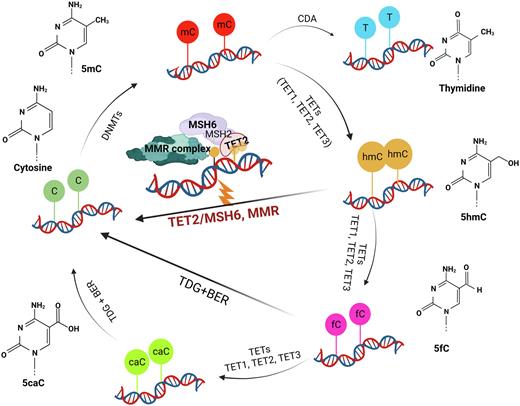Abstract
Epigenetic dysregulation is a common feature of myeloid neoplasia (MN). TET2, along with TET1 and TET3 are the only known enzymes, which progressively oxidize 5-methyl cytosine and thus facilitate active demethylation of CpG islands, a process critical for efficient gene expression and maintenance of genomic integrity. Loss of function TET2 mutations (TET2MT) are one of the most common somatic lesions in MN. To date, the precise mechanisms of TET2MT in leukemogenesis remain unclear. However, two potential mechanisms have been postulated; i) TET2MT may lead to expansion of stem cells by differentiation block and/or increased self-renewal ii) clonally restricted hyper mutations resulting in acquisition of secondary driver mutations. This functional duality may explain proleukemogenic consequences of TET2MT. Both mechanisms are compatible with their relatively moderate driver phenotype. Increased CàT transitions via deamination of 5mC in TET2MT has been postulated; however this report focuses on a novel mechanism of TET2MT- mediated impairment of mismatch repair (MMR).
WES was used for analysis of the mutational status of 435 MN cases to test whether TET2MT (n= 82/435; 19%) predispose to acquisition of additional mutations. Following exclusion of dysfunction in known DNA repair genes, we compared the median SNVs in TET2MT vs. TET2WT. TET2MT cases had nearly a 2-fold increased median SNVs (p<0.0001) vs. TET2WT including a 2.1-fold increase in truncations (p=0.03) with a linear correlation (r=0.7) of SNVs vs. clonality, consistent with a gene-dose effect. ShRNA knockdown of TET2 in HeLa and CRISPR knockout in HEK293 cells resulted in a 24- and 30-fold increase in spontaneous mutations in the HPRT assay. The heightened spontaneous mutability in TET2KO/KD cells were reversed by ectopic expression of TET2. In Tet2-/- mice, ~1.5-fold increased mutagenicity at TET2-dependent active demethylation sites were detected suggesting its direct or indirect involvement in one or more DNA repair pathways.
Consistent with our hypothesis, endogenous co-immunoprecipitation of TET2 followed by tandem-affinity purification and characterization of protein complexes with LCMS/MS in 4 different systems including human leukemic cell lines (K562 and CMK), murine embryonic stem cell and erythroid leukemia cells MEL identified all the major components of DNA MMR complex as a part of TET2 interactome. In every cell line, MSH6, a main component of MMR complex was an abundant TET2 interacting protein. This result was further confirmed by reverse co-immunoprecipitation using anti-MSH6 antibodies in different cell lines. Using truncating deletion constructs of TET2, MSH6 binding site was mapped on TET2 N-terminal amino acid segment 460-942. Functional MMR fluorescence reporter assay, wherein a point mutant of GFP, if repaired, is converted to BFP, demonstrated that loss of TET2 indeed compromised the rate of MMR in CRISPR generated deletion of TET2 in K562 and HEK293 cells. Ectopic expression of N-terminal (aa 460-942) MSH6 binding domain rescued this defect.
The genomic instability due to MMR dysfunction in TET2MT cells may allow therapeutic targeting of DNA repair proteins in a subset of TET2MT MN. Therefore, we tested the therapeutic vulnerability of TET2MT cells against small molecule DNA repair inhibitors (e.g., clinically approved PARP antagonists) in engineered isogenic and natural TET2MT cell lines. The TET2KO/KD cells were 2-10X more sensitive to olaparib and rukaparib compared to parental TET2 proficient cells, both under steady state and under conditions of oxidative stress as observed in gH2AX assays and various apoptotic readouts.
In summary, for the first time here we report that TET2 directly binds to MSH6 and recruits MMR complex to the site of mismatch around CpG islands and facilitate the repair. Loss of TET2impairs this process, explaining the accumulation of secondary hits in mutant clones, which by this virtue, progressively increases their leukemogenic fitness. Given that MSH6 is known to interact 5hmC, TET2 may guide MMR to TET2-dependent DNA loci directly linking TET2MTto genomic instability a biologic feature that can be therapeutically exploited.
Disclosures
Greenberg:Abbvie: Current Employment. Maciejewski:Apellis Pharmaceuticals: Consultancy; Alexion: Consultancy.
Author notes
Asterisk with author names denotes non-ASH members.


This feature is available to Subscribers Only
Sign In or Create an Account Close Modal